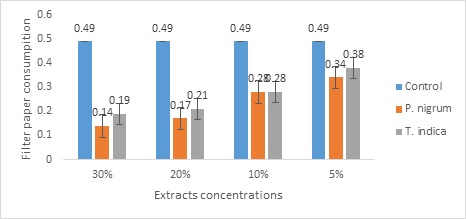Bioactivity of Medicinal Plants Piper nigurm and Tamarindus indica against Heterotermes indicola (Wasmann)
Abstract
 Abstract Views: 0
Abstract Views: 0
Background. Termites, notorious for causing significant damage to crops, plantation forests, and buildings, pose a serious threat as pests. Conventional control methods rely on the use of insecticides, which have been reported to be hazardous to various other forms of life as well. In contrast, lower termites host protozoa in their gut, facilitating cellulose digestion through the release of cellulase enzymes.
Method. This study explored the efficacy of ethanolic leaf extracts from two medicinal plants namely Piper nigrum and Tamarindus indica against Heterotermes indicola (Wasmann). GC-MS analysis of the plant extracts revealed their distinct chemical compositions.
Results. The T. indica extract comprised compounds such as Benzene, 1,1’(1-methylethylidene) Bis [4-methoxy, 3-0-Methyl-d-glucose, Benzoic acid, 3,4,5-trihydroxy-, methyl ester, 9,12,15, octadecatyrien-1-ol, (Z, Z, Z), 1,3,3-Trimethyl-2-hydroxymethyl3,3-dimethyl-4-(3-methylbut-2-enyl), Di-n-decylsulfone, and 2R-Acetoxymethyl-1,3,5-trimethyl4c-(3-methyl-2-buten-1-yl)-1ccyclohexanol. On the other hand, P. nigrum extract contained Octacosanol, Urs-12-en-24-oic acid, 3-oxo-, methyl ester, (+)-, B-Amyrin, Behenic alcohol, and Humulane-1,6-dien-3-ol. Both plant extracts exhibited repellent properties against H. indicola.
Conclusion. The LC50 values for T. indica and P. nigrum were found to be 14.83% and 12.20%, respectively. While, the LC90 values for T. indica and P. nigrum were -4.26% and -1.19%, respectively.
Downloads
References
Cao R, Su N. Tunneling and food transportation activity of four subterranean termite species (Isoptera: Rhinotermitidae) at various temperatures. Ann Entomol. 2014;107(3):696–701. https://doi.org /10.1603/AN13181
Donovan SE, Eggleton P, Dubbin WE, Batchelder M, Dibong L. The effect of a soil-feeding termite, Cubitermes fungifaber (Isoptera: Termitidae) on soil properties: termites may be an important source of soil microhabitat heterogeneity in tropical forests. Pedobiol. 2001;45:1–11. https://doi.org/10.1078/0031-4056-00063
Sattar A, Naeem M, Ehsan-Ul-Haq. Efficacy of plant extracts against subterranean termites i.e. Microtermes obesi and Odontotermes lokanandi (Blattodea:Termitidae). J Biodivers Bioprospect Dev. 2014;1:2–10.
Aihetasham A, Umer M, Akhtar MS, Imran M, Din KZR. Bioactivity of medicinal plants Mentha arvensis and Peganum harmala extracts against Heterotermes indicola (Wasmann)(Isoptera). Int J Biosci. 2015;7(5):116–126.
Kanyi NC, Karuri H, Nyasani JO, Mwangi B. Land use effects on termite assemblages in Kenya. Heliyon. 2021;7:e08588. https://doi.org/10. 1016/j.heliyon.2021.e08588
Ahmad F, Fouad H, Liang SY, Hu Y, Mo JC. Termites and Chinese agricultural system: applications and advances in integrated termite management and chemical control. Insect Sci. 2021;28:2–20. https://doi. org/10.1111/1744-7917.12726
Adfa M, Romayasa A, Kusnanda AJ, et al. Chemical components, antitermite and antifungal activities of Cinnamomum parthenoxylon wood vinegar. J Korean Wood Sci Technol. 2020;48(1):107–116.
Arinana A, Rahman MM, Silaban REG, Himi SK, Nandika D. Preference of subterranean termites among community timber species in Bogor, Indonesia. J Korean Wood Sci Technol. 2022;50(6):458–474.
Rasib KZ, Aihetasham A. Constituents and termiticide potential of some wood extracts against Coptotermes heimi (Wasmann) (Isoptera: Rhinotermitidae). Turkish J Entomol. 2016;40 (2):165–174. https://doi.org/10.16970/ted.94447
Chang ST, Cheng SS, Wang SY. Antitermitic activity of essential oils and components from Taiwania (Taiwania cryptomerioides). J Chem Ecol. 2001;27:1267–1274. https://doi.org/10.1023/a:1010397801826
Zhu BCR, Henderson G, Chen F, Fei H, Laine RA. Evaluation of vetiver oil and seven insect active essential oils against the Formosan subterranean termite. J Chem Ecol. 2001;27(8):1617–1625. https://doi. org/10.1023/A:1010410325174
Singh G, Singh OP, Prasad YR, De-Lampasona MP, Catalan C. Chemical and insecticidal investigations in leaf oil of Coleus amboinicus Lour. J Flav Fragr. 2004;17(6):440–442. https://doi.org/10.1002/ffj.1123
Singh M, Lal K, Singh SB, Singh M. Effect of Calotropis (Calotropis procera) extract on infestation of termite (Odontotermes obesus) in sugarcane hybrid. Indian J Agric Sci. 2002;7(7):439–441.
Blaske VU, Hertel H. Repellent and toxic effects of plant extracts on subterranean termites (Isoptera: Rhinotermitidae). J Econ Entomol. 2001;94(5):1200–1208. https://doi.org /10.1603/0022-0493-94.5.1200
Nair KP. Agronomy And Economy of Black Pepper and Cardamom: The King and Queen of Spices. Elsevier Press; 2011.
Damanhouri ZA, Ahmad A. A review on therapeutic potential of Piper nigrum L. (Black Pepper): the king of spices. Med Aromat Plants. 2014;3(3):e1000161.
Raja BP, Sethuraman MG. Inhibitive effect of black pepper extract on the sulphuric acid corrosion of mild steel. Mater Lett. 2008;62(17-18):2977–2979. https://doi.org/10.1016/j. matlet.2008.01.087
Bhadoriya SS, Ganeshpurkar A, Narwaria J, Rai G, Jain AP. Tamarindus indica: extent of explored potential. Pharmacog Rev. 2011;5(9):73–81. https://doi.org /10.4103%2F0973-7847.79102
Havinga RM, Hartl A, Putscher J, Prehsler S, Buchmann C, Vogl CR. Tamarindus indica L. (Fabaceae): patterns of use in traditional African Medicine. J Ethnopharmacol. 2010;127(3):573–588. https://doi.org/ 10.1016/j.jep.2009.11.028
De Caluw E, Halamov K, Van Damme P. Tamarindus indica L.–a review of traditional uses, phytochemistry and pharmacology. Afrika Focus. 2010;23(1):53–83. https://doi. org/10.21825/af.v23i1.5039
Glew RS, Erjagt DJ, Chuang LTS, Huang Y, Millson M, Glew RH. Nutrient content of four edible wild plants from west Africa. Plant Foods Hum Nutr. 2005;60(4):187–193. https://doi.org/10.1007/s11130-005-8616-0
Kuru P. Tamarindus indica and its health related effects. Asian Pac J Trop Biomed. 2014;4(9):676–681. https://doi.org/10.12980/APJTB.4.2014APJTB-2014-0173
Kadir R, Sarif M, Awang K, Jamil M, Naysir NMFK. Efficiency of Palaquium gutta and Pometia pinnata heartwood extracts on the protection of Hevea brasiliensis against Asian Subterranean termites, Coptotermes gestroi (Wasmann). Arthropod-Plant Interact. 2023;7:373–388. https://doi.org/10.1007/s11829-023-09957-w
Vogel WC, Zieve L. Post-heparin phospholipase. J Lipid Res. 1964;5(2):177–183.
Mankowski M, Boyd B, Babar H, Grant, K. GC-MS characterizations of termiticidal heartwood extractives from wood species utilized in Pakistan. Proceedings of the International Research Group on Wood Protection. 2016:1–16.
Smith, V. K. Improved techniques designed for screening candidate termiticides on soil in the laboratory. J Econ Entomol. 1979;72(6):877–879. https://doi.org/10.1093/jee/72.6.877
Desbois AP, Smith VJ. Antibacterial free fatty acids: activities, mechanisms of action and biotechnological potential. Appl Microbiol Biotechnol. 2010;85:1629–1642. https://doi.org/ 10.1007/s00253-009-2355-3
Mary FPA, Giri SR. GC-MS analysis of bioactive compounds of Achyranthes Aspera. World J Pharm Res. 2018;7(1):1045–1056.
Lukmandaru G, Ogiyama K. Bioactive compounds from ethyl acetate extract of teakwood (Tectona grandis). 6th International Wood Science Symposium LIPI-JSPS Core, Bali, Indonesia. 2005;346–350.
Kartal SN, Hwang WJ, Imamura Y, Sekine Y. Effect of essential oil compounds and plant extracts on decay and termite resistance of wood. Holz Roh Werkst. 2006;64(6):455–461.
Gori G, Carrieri M, Scapellato ML, et al. 2-methylanthraquinone as a marker of occupational exposure to teak wood dust in boatyards. Ann Occup Hyg. 2009;53(1):27–32. https://doi.org/ 10.1093/annhyg/men069
Lukmandaru G, Ashitani T, Takahashi K. Color and chemical characterization of partially black-streaked heart-wood in teak (Tectona grandis). J For Res. 2009;20(4):377–380. https://doi.org /10.1007/s11676-009-0064-5
Bhat IUH, Khalil A, Shuib NS, Noor A. Antifungal activity of the heartwood extracts and their constituents from cultivated Tectona grandis against Phanerochaete chrysosporium. Wood Res. 2010;55:59–66.
Xie CP, Li KF, Lin JL, Li JB. GC-MS analysis on heartwood extractive chemical components of different provenances teak (Tectona grandis L.F). Adv Mat Res Trans Tech Publ. 2011;1049–1053. https://doi.org/10. 4028/www.scientific.net/AMR.236-238.1049
Ameri A, Jasaany A. Evaluation efficacy of some local plants extracts to protect wood and olive tree against infestation with the termite Microcerotermes diversues (silvestri). Iqra J Agric Res. 2017;21(2):128–141.
Tabassum R, Aihetasham A, Zubair A, Qurat-ul-ain, Ashraf A. Termiticidal activity of ethanolic leaf extracts of medicinal plants Calotropis gigantea and Morus alba against Heterotermes indicola (Wasmann). J Popul Ther Clin Pharmacol. 2023;30(19):2192–2203.
Alkali ZD, Abdullahi N. Insecticidal efficacy of ethanolic leaf extract of Tamarindus Indica on the Ovipostion, egg viability and adult emergence of Callosobruchus Maculatus (F.) on treated cowpea seeds. Dutse J Pure Appl Sci. 2017;3(1):72–79.
Qurat-Ul-Ain, Aihetasham A, Tabassum R. Assessing the efficacy of Cassia fistula and Pongamia pinnata extracts against Coptotermes heimi. J Popul Ther Clin Pharmacol. 2024;31(5):478–488. https://doi.org/10.53555/jptcp.v31i5.6147
Cynthia OC, Precious O, Lynda OS. The toxicity and repellency of some plant extracts applied as individual and mixed extracts against termites (Macrotermes bellicosus). J Entomol Zool Studies. 2016;4(1):406–418.
Dungani R, Bhat IH, Khalil HPSA, Naif A, Hermawan D. Evaluation of antitermitic activity of different extracts obtained from Indonesian teakwood (Tectona grandis). Bioresour Technol. 2012;7(2):1452–1461.
Morimoto M, Fukumoto H, Hiratani M, Chavasiri W, Komai K. Insect antifeedants, pterocarpans and pterocarpol, in heartwood of Pterocarpus macrocarpus Kruz. Biosci Biotechnol Biochem. 2006;70(8):1864–1868. https://doi.org/10.1271/bbb.60017
Ateş S, Gur M, Ozkan OE, Akca M, Olgun C, Guder A. Chemical contents and antifungal activity of some durable wood extractives vs. pleurotus ostreatus. Bioresources. 2015;10(2):2433–2443.

Copyright (c) 2024 Ayesha Aihetasham

This work is licensed under a Creative Commons Attribution 4.0 International License.
BSR follows an open-access publishing policy and full text of all published articles is available free, immediately upon publication of an issue. The journal’s contents are published and distributed under the terms of the Creative Commons Attribution 4.0 International (CC-BY 4.0) license. Thus, the work submitted to the journal implies that it is original, unpublished work of the authors (neither published previously nor accepted/under consideration for publication elsewhere). On acceptance of a manuscript for publication, a corresponding author on the behalf of all co-authors of the manuscript will sign and submit a completed the Copyright and Author Consent Form.









